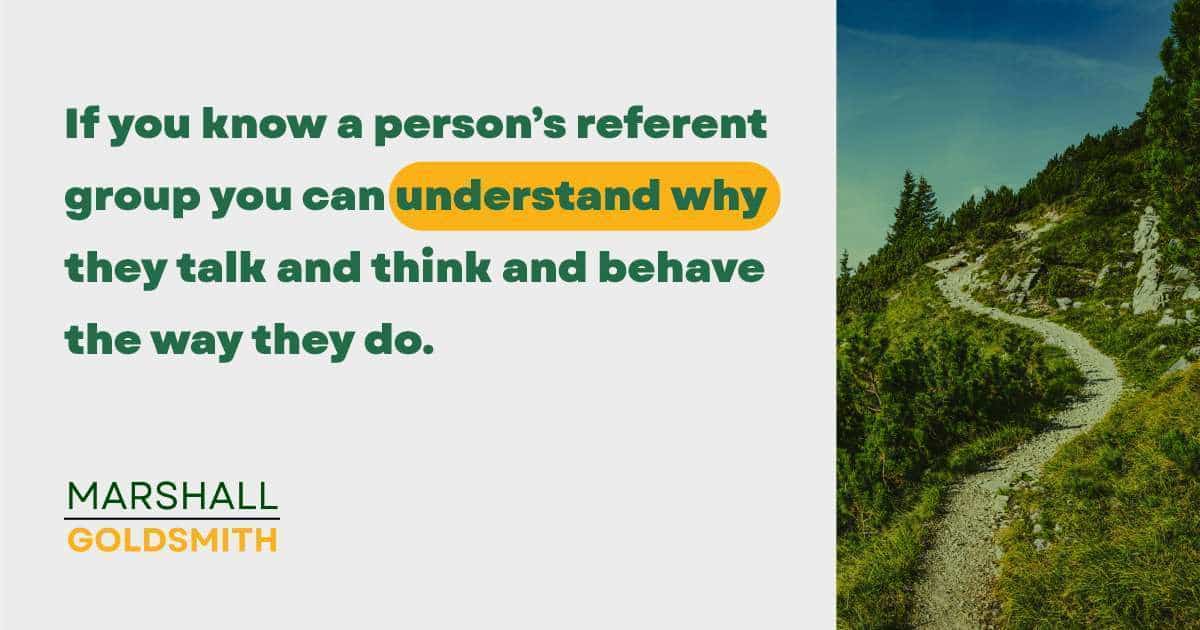Playing Favorites By Marshall Goldsmith There’s a reason I devote...
Over the years, I have had a series of profound epiphanies about how to help people move forward in their work, and their life. These are the concepts of —
Here I’d like to explore the referent group.
In the mid-1970s, Roosevelt Thomas, Jr., the author and leading speaker on diversity in the workplace, introduced me to his idea of referent groups.
At the time, I had a narrow appreciation of its significance. I considered it a concept that Thomas devised to educate corporate America about the need for diversity in the workplace. Roosevelt believed that an organization was richer and stronger when it included a wide range of differences.
The referent group concept was the structure he created to help people understand that if an individual identified with a particular referent group, his or her desire for approval from this group shaped his or her behavior and performance.
People would do almost anything to be accepted by the tribe they identify with. Part of Thomas’s structure for corporate America was a distinction between what he called preference and requirement. A person’s preferences—how they dress, the music they like, the political views they hold—are not relevant if the same person meets or exceeds the requirements of the job. If leaders could accept that distinction—that a direct report’s preferences don’t have to correlate with the job’s requirements—it would allow a lot of differences and eccentricities in the workplace.

Leaders would be less aggrieved by superficialities, less obsessed with conformity, and their direct reports would feel more welcome. It was a brilliant insight, aimed at enlightening a leader’s point of view about individuals on a team.
I saw the concept from the viewpoint of how it helped executives become better leaders. I failed to appreciate the power of referent groups from the other side, namely, the viewpoint of the referent group members.
I wasn’t adept at applying the concept beyond the workplace or, for that matter, in my own life. For decades, I’d been frustrated by otherwise intelligent people whose social values and knowledge base didn’t make sense to me. How could they believe things that, at least to me, x were so ignorant and illogical? My confusion persisted well into my 60s.
Then I recalled Roosevelt Thomas’s main point: If you know a person’s referent group—to whom or what they feel deeply connected, whom they want to impress, whose respect they crave—you can understand why they talk and think and behave the way they do. You don’t have to agree with them, but you are less likely to dismiss them as brainwashed or uninformed. At the same time, you realize that your views may appear equally incomprehensible to them.
It made me more tolerant, almost empathic. It also started me thinking about the utility of referent groups.
Was there a structure into which I could fold Roosevelt’s insight to help people change their behavior?
Roosevelt Thomas was a giant onto whose shoulders I should have climbed much sooner.

Adding Too Much Value Won’t Get You There By Marshall...
C-Suite Master Class: No, But, However By Marshall Goldsmith Continuing...
The Doerr Institute: Expanding the Market for Coaches By Marshall...
Making Leadership Development Part of the College Degree at Rice...
Sanyin Siang – Winner of the Thinkers50 Marshall Goldsmith Coaching...
Thinkers50 Marshall Goldsmith Distinguished Achievement Award in Coaching – Nominees...
Leading with Influence: What Is Influence360°? By Marshall Goldsmith Founder...
Are You a Dominator, Manipulator, Persuader or Influencer? By Marshall...
Leading with Influence: Redefining Modern Influence Part 2 By Marshall...
My mission is simple. I want to help successful people achieve positive, lasting change and behavior; for themselves, their people, and their teams. I want to help you make your life a little better. With four decades of experience helping top CEOs and executives overcome limiting beliefs and behaviors to achieve greater success, I don’t do this for fame and accolades. I do this because I love helping people!
As an executive educator and coach, I help people understand how our beliefs and the environments we operate in can trigger negative behaviors. Through simple and practical advice, I help people achieve and sustain positive behavioral change.